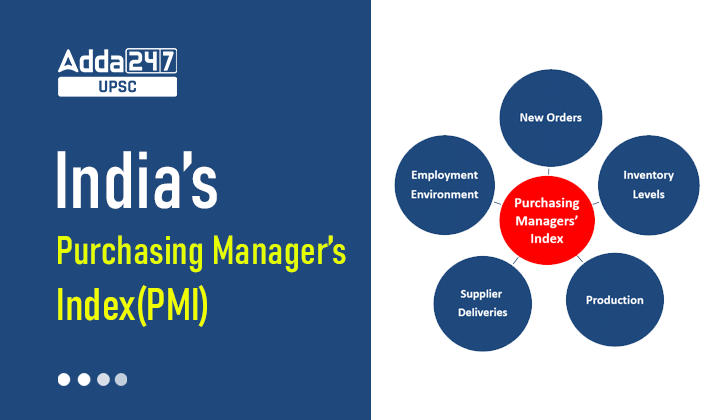Table of Contents
India’s Manufacturing Purchasing Managers’ Index (PMI): Why in news?
- According to the S&P Global’s Purchasing Managers’ Index, India’s manufacturing PMI rose to 55.3 from 55.1 in September, data released on November 1 showed.
- It is also above its long-run average (53.7) and indicates a stronger improvement in the health of the sector.
- The upward movement in the headline figure largely reflected stronger increases in employment and stocks of purchases.
India’s Manufacturing Purchasing Managers’ Index (PMI): What is S&P Global?
- S&P is a Global rating agency that enables governments, businesses, and individuals with the right data, expertise and connected technology so they can make decisions with conviction.
- They are widely sought after by many of the world’s leading organizations to provide credit ratings, benchmarks, analytics and workflow solutions in the global capital, commodity and automotive markets.
India’s Manufacturing Purchasing Managers’ Index (PMI): What does the PMI index mean?
- PMI or a Purchasing Managers’ Index (PMI) is an indicator of business activity — both in the manufacturing and services sectors.
- It is a survey-based measures that asks the respondents about changes in their perception of some key business variables from the month before. It is calculated separately for the manufacturing and services sectors and then a composite index is constructed.
- The PMI is widely used to anticipate changing economic trends in official data such as GDP, or sometimes as an alternative gauge of economic performance and business conditions to official data, as the latter sometimes suffer from delays in publication, poor availability or data quality issues.
- The PMI is produced globally by IHS Markit although a small number of trade associations also produce local PMIs in certain markets, such as the ISM in the United States.
- The PMI is widely seen as an accurate and timely indicator of business conditions that helps analysts and economists to correctly anticipate changing economic trends in official data series such as gross domestic products (GDP), industrial production, employment and inflation.
- Because PMI data are sometimes released months ahead of comparable official data, the PMI surveys are ranked among the world’s most market moving economic data releases.
India’s Manufacturing Purchasing Managers’ Index (PMI): What is a services PMI?
- The services PMI was introduced in 1996 by IHS Markit’s economists (known as NTC Research at the time) to accompany the existing manufacturing PMI.
- With the service sector accounting for a larger proportion of GDP than manufacturing for most developed economies, the services PMI was born out of a need for analysts (and in particular central bank policymakers) to better understand changing business conditions in the wider economy.
- The services PMI has fewer questions than the manufacturing PMI due to some questions, such as inventories, not being relevant to many service providers.
- Coverage includes financial services, consumer services and all other business services.
India’s Manufacturing Purchasing Managers’ Index (PMI): What is manufacturing Purchasing Managers’ Index?
- A manufacturing Purchasing Managers’ Index(PMI) is a survey-based economic indicator designed to provide a timely insight into changing business conditions in the goods-producing sector.
- However, the definition of ‘Manufacturing PMI’ may describe the survey generically as well as specifically the headline indicator from the survey.
- The latter is a weighted average of diffusion indices from five survey questions. The weights were originally determined by Theodore Torda of the US Department of Commerce to improve the accuracy of the survey data in anticipating changes in GDP.
- New orders, which tend to move in advance of other indicators, are given the highest weight (30%), followed by output (25%) and employment (20%), then followed by suppliers’ delivery times (inverted, with a weight of 15%) and finally inventories of goods purchases (10%).
India’s Manufacturing Purchasing Managers’ Index (PMI): Signs of Resilience by the Indian Manufacturing Industry
- The Indian manufacturing industry again showed signs of resilience in October, with factory orders and production rising strongly despite losing growth momentum.
- “Manufacturers continued to loosen the purse strings as they expect demand buoyancy to be sustained in coming months.
- There was a marked rise in input purchasing, with firms adding to their inventories to better align with client purchasing.
- Capacities were again expanded to accommodate for improving sales.
- The Future Output Index component indicated robust business optimism towards the year-ahead outlook for output.
- Consumer goods was the best-performing category in October, recording the greatest performances for output, total sales and exports.
- Growth for all of the aforementioned areas was sustained in the intermediate and investment goods sub-sectors, albeit with slowdowns since September.



 TSPSC Group 1 Question Paper 2024, Downl...
TSPSC Group 1 Question Paper 2024, Downl...
 TSPSC Group 1 Answer key 2024 Out, Downl...
TSPSC Group 1 Answer key 2024 Out, Downl...
 UPSC Prelims 2024 Question Paper, Downlo...
UPSC Prelims 2024 Question Paper, Downlo...




